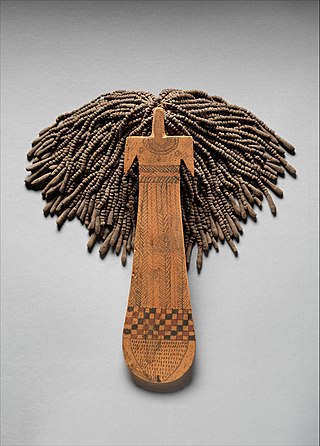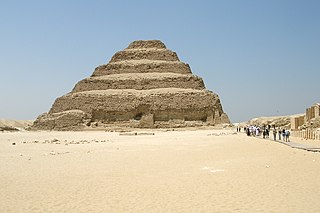This article concerns the period 759 BC – 750 BC.

Senet or senat is a board game from ancient Egypt that consists of 10 or more pawns on a 30 square playing board. The earliest representation of senet is dated to c. 2620 BCE from the Mastaba of Hesy-Re, while similar boards and hieroglyphic signs are found even earlier, including in the Levant in the Early Bronze Age II period. Even though the game has a 2000-year history in Egypt, there appears to be very little variation in terms of key components. This can be determined by studying the various senet boards that have been found by archaeologists, as well depictions of senet being played throughout Egyptian history on places like tomb walls and papyrus scrolls. However, the game fell out of use following the Roman period, and its original rules are the subject of conjecture.

A mudbrick or mud-brick is an air-dried brick, made of a mixture of mud mixed with a binding material such as rice husks or straw. Mudbricks are known from 9000 BCE.

Boutros Ghali was the prime minister of Egypt from 1908 to 1910.

Menpehtyre Ramesses I was the founding pharaoh of ancient Egypt's 19th Dynasty. The dates for his short reign are not completely known but the time-line of late 1292–1290 BC is frequently cited as well as 1295–1294 BC. While Ramesses I was the founder of the 19th Dynasty, his brief reign mainly serves to mark the transition between the reign of Horemheb, who had stabilized Egypt in the late 18th Dynasty, and the rule of the powerful pharaohs of his own dynasty, in particular his son Seti I, and grandson Ramesses II.

The Sed festival was an ancient Egyptian ceremony that celebrated the continued rule of a pharaoh. The name is taken from the name of an Egyptian wolf god, one of whose names was Wepwawet or Sed. The less-formal feast name, the Feast of the Tail, is derived from the name of the animal's tail that typically was attached to the back of the pharaoh's garment in the early periods of Egyptian history. This tail might have been the vestige of a previous ceremonial robe made out of a complete animal skin.

Hedjkheperre Setepenre Smendes was the founder of the Twenty-first Dynasty of Egypt and succeeded to the throne after burying Ramesses XI in Lower Egypt – territory which he controlled. His Egyptian nomen or birth name was actually Nesbanebdjed meaning "He of the Ram, Lord of Mendes", but it was translated into Greek as Smendes by later classical writers such as Josephus and Sextus Africanus. According to the Story of Wenamun from c. 1000 BC, Smendes was a governor of Lower Egypt during the Era of the Renaissance under the reign of Ramesses XI, however, Egyptologists have questioned the historical accuracy of that story.
Kom el-Hisn is a Nile Delta settlement dating back to the Old Kingdom of Egypt with parts dating to the Middle Kingdom. Its location in the 3rd nome of Lower Egypt, or "House of the Lord of Ships ", focus on the goddess Hathor, as well as faunal and textual evidence suggests it played a role in transporting cattle between regions. Whether or not it was a self-sufficient town or built solely to support the temple is currently unknown.

In Ancient Egyptian society, hair was an embodiment of identity. It could carry religious and erotic significance and portray information about gender, age, and social status. During the New Kingdom, more elaborate hairstyles for men and women, incorporating curls and plaits, began to be favored over the traditional, simple hairstyles of the Old and Middle Kingdoms.

Paddle dolls are a type of ancient Egyptian female figurine that have been excavated from various tombs. Paddle dolls have been found in burials from the late Sixth Dynasty to the Thirteenth Dynasty from tombs in Asasif, Beni Hassan, Naga el-Deir, Rifeh, Sheikh Farag and Thebes. The period of their greatest popularity seems to have been the late Eleventh and early Twelfth Dynasties.
Lyla Pinch Brock is a Canadian Egyptologist, specializing in epigraphy. She lives in Saissac, France.

The Third Dynasty of ancient Egypt is the first dynasty of the Old Kingdom. Other dynasties of the Old Kingdom include the Fourth, Fifth and Sixth. The capital during the period of the Old Kingdom was at Memphis.

Excerebration is an ancient Egyptian mummification procedure of removal of the brain from corpses prior to actual embalming. Greek writer Herodotus, a frequent visitor to Egypt, wrote in the fifth century B.C. about the process, "Having agreed on a price, the bearers go away, and the workmen, left alone in their place, embalm the body. If they do this in a perfect way, they first draw out part of the brain through the nostrils with an iron hook, and inject certain drugs into the rest".

William Joseph Murnane was an American Egyptologist and author of a number of books and monographs on Ancient Egypt. He was director of the Great Hypostyle Hall Project at Luxor Karnak Temple, was a research associate and held a Dunavant Professorship in the History Department of the Institute of Egyptian Art & Archaeology at the University of Memphis. Several of his scholarly monographs are used as standard references by historians and philologists whilst more popular works, which drew on his considerable knowledge of Ancient Egyptian monuments, are used by tourists.
Psammetichus IV or Psamtik IV is a proposed ancient Egyptian ruler who lived during the First Persian Period.
Mary Ann Eaverly is Professor of Classics at the University of Florida known for her work on Archaic Greek sculpture.

Queen Puabi's headdress is a 2600-2450 BCE Mesopotamian crown consisting of ornate gold leaf wreaths, strands of lapis lazuli and carnelian beads, with a gold comb, and delicate hair ribbons. The entirety of the headdress is estimated to weigh over 6 pounds. The headdress was discovered resting on Queen Puabi's remains in PG 800 during the excavation of the Royal Cemetery at Ur that began in 1922 and concluded in 1934. Successive Mesopotamian societies built new cities on top of previous civilizations and commonly created tells to preserve human remains. These younger tells hid and protected her immense riches by making them inaccessible to looters. Found next to Queen Puabi's remains was a cylinder (identification) seal with the title "nin" inscribed, indicating a great lady or queen. In the grave, excavators also found the remnants of female attendants –– adorned in similar jewelry and hair ribbons –– whose purpose was to serve the queen in her afterlife. The religious significance of Queen Puabi's headdress demonstrates her royal status as well as her cultic importance. The unearthing of Ur was led by Charles Leonard Woolley and was a joint expedition sponsored by the Penn Museum and the British Museum. The headdress currently resides in the Penn Museum in Philadelphia. The excavation is still very popular because of the riches discovered, the uncovering of a mass grave, and the potential connection with Abraham from the book of Genesis.
Priestess of Hathor or Prophetess of Hathor was the title of the Priestess of the goddess Hathor in the Temple of Dendera in Ancient Egypt.

Anra scarabs are scarab seals dating to the Second Intermediate Period found in the Levant, Egypt and Nubia. Anra scarabs are identified by an undeciphered and variable sequence of Egyptian hieroglyphs which appear on the base of the scarab which always include the symbols ̔, n and r. As anra scarabs have overwhelmingly been found in Palestine (~80%), it has been suggested it was marketed by the contemporaneous 15th Dynasty for the Canaanites.
Oric Bates was an American archaeologist and author. Bates worked at multiple institutions including the Boston Museum of Fine Arts where he served as the director of the Egyptian Department and the Peabody Museum of Archaeology and Ethnography where he was a curator in African ethnology. Notable works by Bates include "The Eastern Libyans," "A Madcap Cruise," and Siwan Superstitions." Bates also led expeditions in Libya and Sudan.













